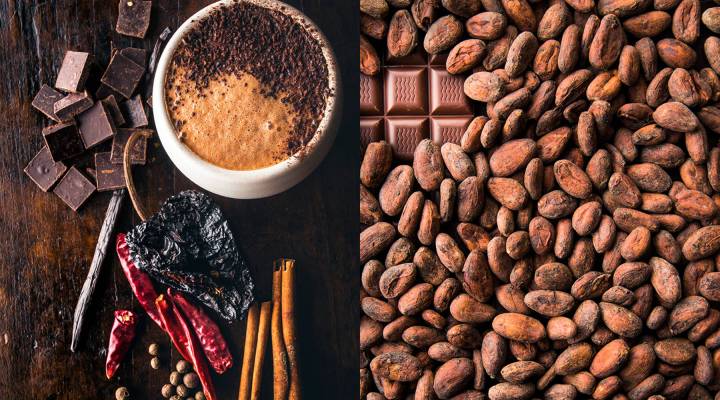
4 things you didn’t know about chocolate

If you’ve ever bitten into a chocolate bar and wondered where it came from, Dandelion Chocolate has a wrapper for you. Its single-origin chocolate bars usually have the name of the farmer who grew the beans on the label, in addition to the location it was sourced from, the year of the harvest and the name of the Dandelion employee who sourced the cocoa. The amount of detail on the label is reminiscent of the attention given to the label on a bottle of wine — and the price might be, too — Dandelion’s chocolate bars cost $8-13.
CEO and co-founder Todd Masonis says that’s intentional. It’s part of Dandelion’s small business mentality, key to the company’s relationship with farmers and, maybe most importantly, on brand. Dandelion Chocolate is meant to be selective, much like the process of making a bar, which involves sorting out bad beans from good ones, roasting the beans in a specialized machine and three to five days of grinding. The final product is just cocoa and sugar.
Masonis and his cocoa bean sourcer, Greg D’Alesandre, compare the changes going on in the chocolate industry to the rise in popularity of craft beer and boutique coffee roasters. Their recent book, “Making Chocolate,” offers a look at what’s going on in the world of chocolate and some insight into how to make it yourself.
Below are four things you probably didn’t know about chocolate:

1. You can make chocolate bars at home. Yup, if you buy unroasted cocoa beans, you can go through the chocolate-making process at home, and even roast them in your oven. All you need are cocoa beans and sugar. The steps from bean to bar are much easier to carry out in a chocolate factory, but it’s possible to make chocolate without specialized equipment (or to invest in some to step up your roasting and refining game). Be mindful though, unroasted cocoa beans are a contamination hazard — they’re a carrier for salmonella — so handle them carefully.
2. There’s a difference between fair trade and direct trade. When it comes to sourcing cocoa beans, chocolate companies do things in a few different ways. You might see chocolate (or coffee, etc.) that is certified fair trade or certified sustainable. Third-party certification groups manage trade partnerships between cocoa bean growers and chocolate makers who work together indirectly. Direct trade is another option used by many chocolate companies — this trading practice requires the maker to meet with the grower and trade directly with them so that they can ensure fair and ethical farming and labor practices.
3. Chocolate is a commodity, but it’s not truly fungible. Fungible essentially means interchangeable, but cocoa beans from Costa Rica aren’t the same as beans grown in Tanzania or Belize. Not only is the chocolate product made from the beans different, there are significant disparities in the farming costs and cost of living in these countries. To create an ethical chocolate market with good labor practices, pricing sometimes reflects the source of the beans.
4. A chocolatier is not the same as a chocolate maker. Chocolate makers make chocolate out of cocoa beans. Chocolatiers make chocolates out of chocolate. Confused? Chocolate makers go from bean to bar; chocolatiers go from bar (or other chocolate shape) to candy. Masonis said that back when Dandelion got started in 2010, there were only about 10 small companies in the U.S. making bean to bar chocolate. Now, he says there are over 250, which means that chocolate is really having a moment.
Looking for a way to enjoy chocolate outside of bar form? Try Dandelion Chocolate’s recipe for European Drinking Chocolate:

Yield: Five 4-ounce servings
Recommended chocolate profile: Chocolatey, nutty, rich fudge brownie.
This recipe is a wonderful vehicle for tasting chocolates from different origins side by side. Sometimes the warm milk and brown sugar seem to draw out flavors you don’t taste as strongly in the chocolate alone, like the grassy notes in an earthy bar, or the softer citrusy finish of a berrylike chocolate. Note that stronger flavors can be amplified in a warm drink as well, which is why we usually steer clear of chocolates that are especially tart and recommend something rounder and more classically chocolatey. But, you do you.
This hot chocolate is our most popular drink, and it tastes a lot like a pure melted chocolate bar. This recipe was developed by our first pastry chef, Phil Ogiela, who’s also responsible for the House Hot Chocolate (page 254) and the Mission Hot Chocolate (page 258). It’s a rich sipping chocolate, a cross between the strong, water-based hot chocolate in Paris and the almost thick-as-pudding Italian kind. An Italian customer once told us it was better than anything he could find at home, and we’ll just go ahead and believe him.
Ingredients:
2 cups / 454 grams / 16 ounces whole milk
1 tablespoon packed / 10 grams light brown sugar
1½ cups / 227 grams / 8 ounces chopped 70 percent chocolate
Marshmallow (page 270), for serving (optional)
Directions:
Combine 1 cup (227 grams / 8 ounces) of milk and the brown sugar in a large heatproof bowl set over a pot of simmering water. Heat the milk mixture until steaming, whisking occasionally.
Whisk the chocolate into the hot milk, keeping the bowl over the double boiler to continue heating it. Whisk for an additional 3 minutes, until shiny and emulsified. It may seem quite thick.
Whisk in the rest of the milk, adding it in a slow stream, and heat for another 4 to 5 minutes, whisking occasionally, until the mixture is steaming.
Remove the bowl from the pot of water and pour the hot chocolate into mugs. Serve immediately. We recommend it with a few marshmallows, if desired.
There’s a lot happening in the world. Through it all, Marketplace is here for you.
You rely on Marketplace to break down the world’s events and tell you how it affects you in a fact-based, approachable way. We rely on your financial support to keep making that possible.
Your donation today powers the independent journalism that you rely on. For just $5/month, you can help sustain Marketplace so we can keep reporting on the things that matter to you.


















